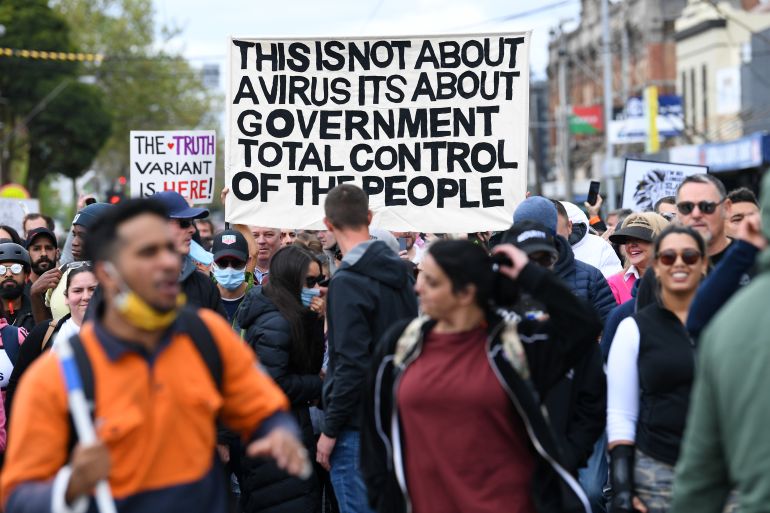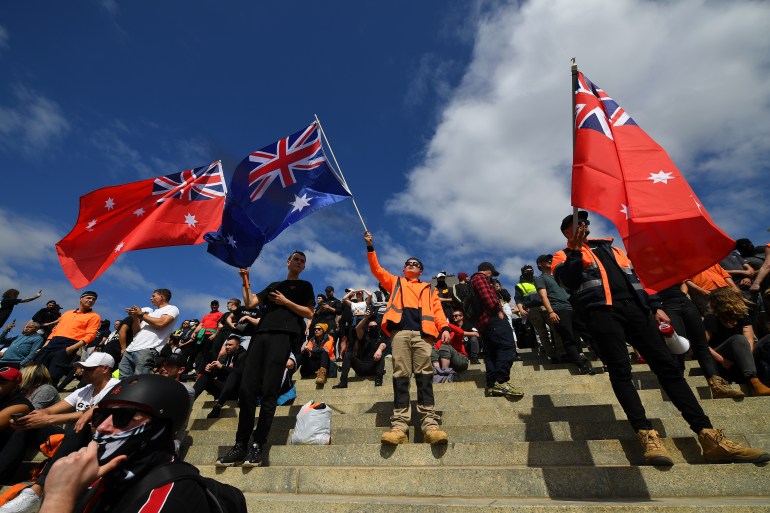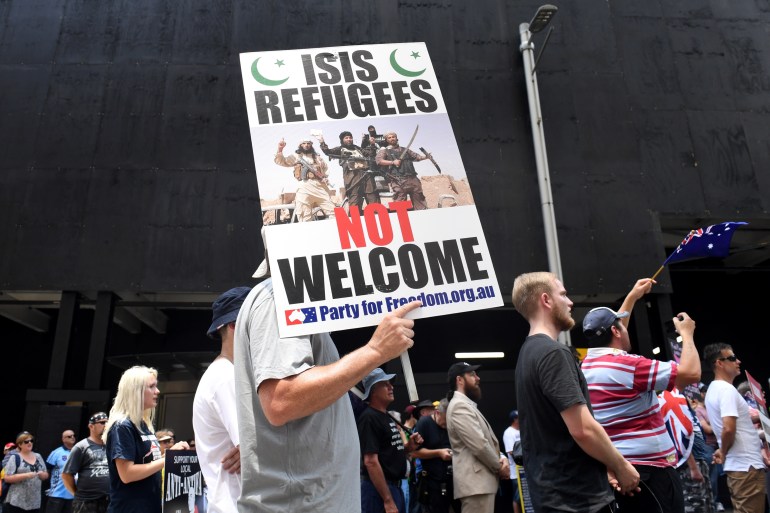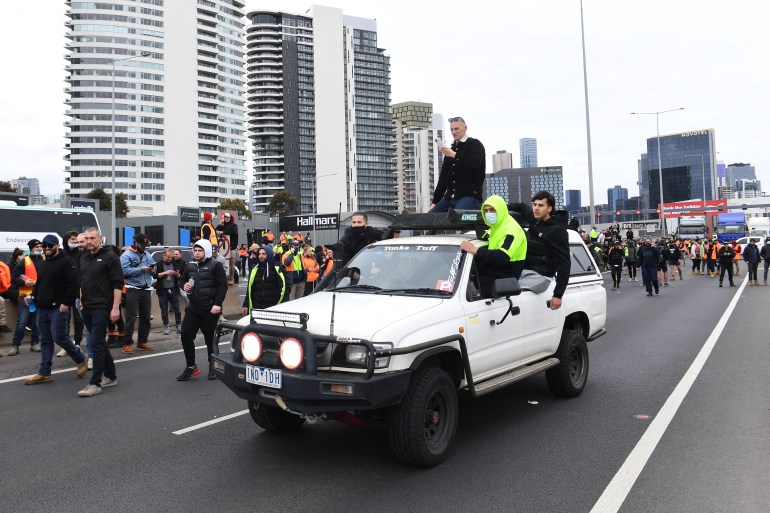Australia’s far right gets COVID anti-lockdown protest booster
Experts say coronavirus conspiracies and anger over prolonged lockdowns provide fertile ground for the far right.

Melbourne, Australia – Recent anti-lockdown protests in Melbourne have exposed the rise of the far-right movement over fears stemming from the coronavirus pandemic, unemployment, and continuing lockdown measures.
The most recent — and arguably most violent — protests were sparked by the state government’s decision to suspend work on building sites for two weeks and make vaccination mandatory for construction workers.
Keep reading
list of 4 itemsAustralia’s borders to reopen in November after 18-month closure
‘Here to stay’: Indo-Pacific Quad leaders to meet at White House
Quad leaders press for ‘free’ Indo-Pacific amid China tensions
Construction workers protesting at the trade union offices in Melbourne, Australia’s second-biggest city, were joined by several other groups, many from far-right backgrounds.
The protest soon turned violent, with police responding with rubber bullets, tear gas and pepper spray.
“Very quickly we saw ‘freedom marchers’ join the protests [with] other right-wing antagonists,” far-right analyst Josh Roose, a senior research fellow at the Alfred Deakin Institute in Melbourne, told Al Jazeera.
“That then gave the impression of being a much larger movement than it necessarily was at the very beginning of that day. It’s gone from a couple of hundred angry trade unionists to several thousand people.”
The protests have focused attention once again on the far right in Australia, two years after an Australian white supremacist attacked two mosques in Christchurch, New Zealand, killing 51 people.
Condemnation of the September rallies was widespread, with Labor Member of Parliament Bill Shorten publicly dismissing the protesters largely as “hard-right man-baby Nazis”.
But Roose — who has previously advised governments about such groups — says such stereotypes are simplistic and misleading.
He says for Australia to combat the far right, people need to understand what it is, and that such groups are more than just “jackboots and swastikas” even if they have previously held public displays of Nazi symbolism and salutes.
“The far right is a lot more nuanced. It has evolved and taken new shapes and morphed into something far more sophisticated than that stereotype,” he said. “The far right has its vocabulary. It has far-right discourse. It’s anti-Semitic. It’s racist. It’s anti-Muslim. It’s primarily anti-women.”

“It is deeply anti-science and propagates disinformation and distrust in government. It views the world as governed by liberal elites who are oppressing and corrupting wider society, and to that extent, it overlaps nicely with conspiracy theories.”
Such conspiracy theories, circulated primarily on social media, include the belief that COVID-19 is a hoax, the vaccine is designed to kill people, or that the recent rollout of 5G technology is to blame for the pandemic.
Pandemic disinformation has also recently crept into the federal Parliament, with Liberal MP George Christensen publicly promoting the use of ivermectin as a coronavirus treatment — despite the Therapeutic Goods Administration, Australia’s medicine regulatory agency, banning its use for the disease.
It is this overlap that Roose says is concerning, and coupled with unemployment and time spent on social media, it has created an avenue for disgruntled people to gravitate towards the far right.
“People have been out of work for the best part of 18 months,” he said. “There are a lot of people sitting at home feeling angry, on social media and looking for someone to blame.”
Mario Peucker, author of The Far Right in Contemporary Australia, agrees.
He says the current social context in Australia is a “breeding ground” for far-right recruitment, and that suspicion of government “resonates with the narrative of far-right groups – that the government is not to be trusted”.
Peucker adds that while the emergence of the far right in Australia may seem like a new phenomenon, it has its roots in the nation’s history.
“In terms of racism and xenophobia, we have to start by acknowledging that the nation-building process in Australia is built on an idea of white supremacy and racism,” he said.
Racist history
Australia was settled by British colonialists in the 18th century, who declared the country “terra nullius”, a Latin term meaning no-one’s land. They dispossessed the Aboriginal and Torres Strait Islander peoples of their land — where they had lived for tens of thousands of years.
European culture was portrayed as superior to that of the Indigenous people who suffered brutal massacres, and often died from exposure to diseases that the colonialists brought with them.
Subsequent governments orchestrated the removal of Aboriginal children from their families, and a “White Australia” immigration policy ended only in the mid-1970s.
More recently, anti-refugee and anti-Muslim sentiment has emerged, often fuelled by elected politicians such as One Nation’s Pauline Hanson.

Peucker says the recent emergence of the far right was triggered around the media-driven anti-Muslim “moral panic” surrounding the rise of ISIS (ISIL) in the mid-2010s, bolstered by the 2016 election of Donald Trump as US president, and emboldened by right-wing sections of the Australian media.
What Peucker calls “an exponential growth in far-right groups” that is now being fuelled by the coronavirus pandemic, has not gone unnoticed by Australia’s security services.
Director General of the Australian Security Intelligence Organisation (ASIO) Mike Burgess said last year that a third of his organisation’s resources were currently deployed to address the threat of violence by far-right groups.
In an online statement, he said that “right-wing extremists are more organised, sophisticated, ideological and active than previous years.”
“Many of these groups and individuals have seized on COVID-19, believing it reinforces the narratives and conspiracies at the core of their ideologies. They see the pandemic as proof of the failure of globalisation, multiculturalism and democracy, and confirmation that societal collapse and a ‘race war’ are inevitable.”
But Peucker says that there is a “gap” in ASIO’s response — noting that the security organisation was largely concerned with immediate threats of violence, and that it needed to “intervene earlier” to combat entry into such groups.
The Australian Muslim Advocacy Network, a community and legal group that works to safeguard the safety of Australian Muslims, agrees.
“The government needs to crack down on the bad actors who are dehumanising minorities through disinformation and the platforms that enable them,” the group said in a statement to Al Jazeera.
They said that their research showed Facebook and Twitter act “too late on disinformation, and with a very poor success rate.”
‘Get people back to work’
In response to the rising threat, the Victorian Greens recently announced that they will be calling for a state inquiry into the rise of far-right groups in Victoria, of which Melbourne is the capital.
Leader and spokesperson Samantha Ratnam told Al Jazeera that her party has been “concerned about the rise of the far-right in Victoria for a number of years, but there’s been an escalation in recent months, now that the pandemic seems to have provided the perfect breeding ground for their dangerous ideology.”
Ratnam has herself been abused by far-right supporters: “Not long after I entered [Victorian] Parliament in 2018, I was harassed and followed from my office by right-wing extremists,” she said. “It was frightening. And the attacks on me online have increased over the last year.”
The Greens’ inquiry will investigate the far right’s methods of recruitment and communication, the risks their plans pose to Victoria, their links with anti-vaccine misinformation groups, and the steps necessary to counter their influence, she said.

Roose says getting people back to work as soon as possible can also help combat the appeal of hardline ideologies.
“People are quite literally fed up and just want to get back to work, which is critical for their socialisation, critical for their self-esteem and sense of purpose in the world,” he said.
“If we get people back to work — and kids back to school — we will start to see the potential for these mass movements dissipate significantly.”
Yet despite an announcement on easing restrictions, Melbourne’s continuing lockdown – now the longest, and some say toughest, measures in the world – means that a return to employment for many may not occur until the end of this year.
That the state government has made vaccination mandatory for many industries to return to work has also proved contentious, and is unlikely to dispel anti-government sentiment.
Tackling the issue over the longer term may prove more challenging given the far right’s deep-seated cultural roots.
“The question is what do you do with far-right extremism when they draw on strong currents that are embedded in Australian culture and politics of racism, anti-migration and a deep-seated misogyny? That’s one of the significant challenges in seeking to address the emergence of the far right,” Roose said.